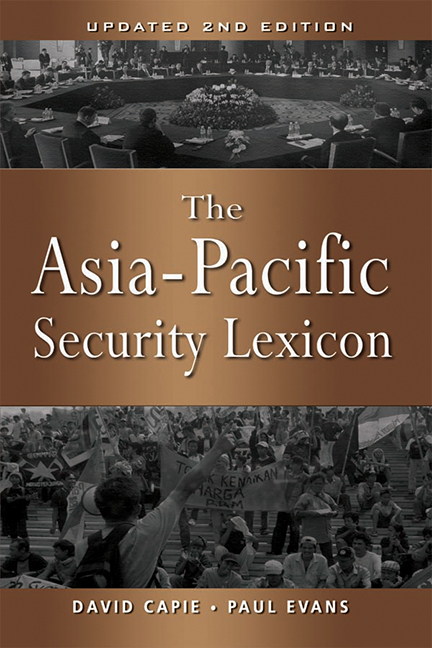Book contents
- Frontmatter
- Contents
- Abbreviations
- Introduction to the Second Edition
- Ad Hoc Multilateralism
- A la Carte Multilateralism
- The “ASEAN Way”
- Balance of Power
- Bilateralism
- Coalition of the Willing
- Coercive Diplomacy
- Collective Defence
- Collective Security
- Common Security
- Comprehensive Security
- Concert of Powers
- Concerted Unilateralism
- Confidence-Building Measures
- Confidence- and Security-Building Measures
- Constructive Intervention
- Cooperative Security
- Engagement
- Flexible Consensus
- Human Security
- Humanitarian Intervention
- Middle Power
- Multilateralism
- Mutual Security
- New Security Approach
- Non-Traditional Security
- Open Regionalism
- Peaceful Rise
- Pre-emption and Preventive War
- Preventive Diplomacy
- Security Community
- Terrorism
- Track One
- Track One-and-a-Half
- Track Two
- Track Three
- Transparency
- Trust-Building Measures
- About the Authors
Pre-emption and Preventive War
Published online by Cambridge University Press: 21 October 2015
- Frontmatter
- Contents
- Abbreviations
- Introduction to the Second Edition
- Ad Hoc Multilateralism
- A la Carte Multilateralism
- The “ASEAN Way”
- Balance of Power
- Bilateralism
- Coalition of the Willing
- Coercive Diplomacy
- Collective Defence
- Collective Security
- Common Security
- Comprehensive Security
- Concert of Powers
- Concerted Unilateralism
- Confidence-Building Measures
- Confidence- and Security-Building Measures
- Constructive Intervention
- Cooperative Security
- Engagement
- Flexible Consensus
- Human Security
- Humanitarian Intervention
- Middle Power
- Multilateralism
- Mutual Security
- New Security Approach
- Non-Traditional Security
- Open Regionalism
- Peaceful Rise
- Pre-emption and Preventive War
- Preventive Diplomacy
- Security Community
- Terrorism
- Track One
- Track One-and-a-Half
- Track Two
- Track Three
- Transparency
- Trust-Building Measures
- About the Authors
Summary
On 1 June 2002, President George W. Bush delivered one of the most remarked upon speeches of the first term of his presidency. Speaking to new graduates at the West Point military academy in New York, he announced what he would later call a “new doctrine” underpinning U.S. national security policy. While containment and deterrence had been the bedrock of American strategy for much of the last century, Bush argued that, “new threats … require new thinking. Deterrence means nothing against shadowy terrorist networks with no nation or citizens to defend. Containment is not possible when unbalanced dictators with weapons of mass destruction can deliver those weapons on missiles or secretly provide them to terrorist allies.” Rather than rely solely on these approaches, the president announced that the war on terror required America to “take the battle to the enemy, disrupt his plans, and confront the worst threats before they emerge…. Americans [must be] ready for pre-emptive action when necessary to defend our liberty and to defend our lives.”
Bush's call for “pre-emptive action” was reaffirmed and expanded upon in the National Security Strategy of the United States of America (NSS) released on 20 September 2002. The NSS discusses pre-emption in the context of international law, saying that legal scholars have long “recognized that nations need not suffer an attack before they can lawfully take action to defend themselves against forces that present an imminent threat of attack.” However, the report goes on to argue the United States “must adapt the concept of imminent threat” to the capabilities and objectives of today's adversaries. The potential for terrorists to attack using weapons of mass destruction means “the greater the risk of inaction — the more compelling the case for taking anticipatory action to defend ourselves, even if uncertainty remains as to the time and place of the enemy's attack. To forestall or prevent such hostile acts… the United States will, if necessary, act preemptively.”
- Type
- Chapter
- Information
- The Asia-Pacific Security Lexicon (Upated 2nd Edition) , pp. 191 - 198Publisher: ISEAS–Yusof Ishak InstitutePrint publication year: 2007



